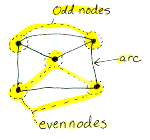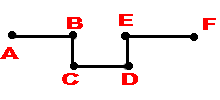 Mathematical
"T" Words
Mathematical
"T" Words
*Dictionary
Alert
table An arrangement of data in rows and columns.
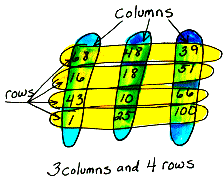
Take-away Model for Subtraction If a quantity y is taken away from an original quantity x with the same units, the quantity left is x - y.
tangent
A line, ray, segment, or plane which intersects a curve or curved surface
in exactly one point.
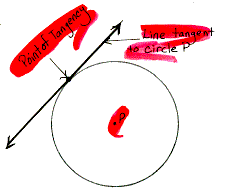
tangent
of an angle The
ratio (length of leg opposite to the angle/length of leg adjacent to the
angle) in a right triangle. Abbreviated tan.
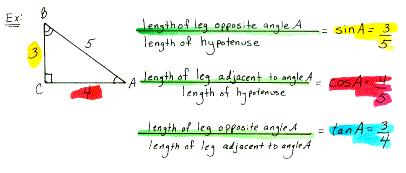
tangent circles Two circles that have exactly one point in common.
EX: Here we see a design made of lots of tangent circles.
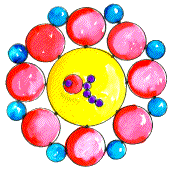
terminal
point
The endpoint of a vector.
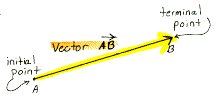
terminating decimal A decimal that ends. Also called finite decimal.
terms Numbers or products of numbers and variables that are added.
Ex: 3x +-8xy + 9 is an expression with three terms.
Ex:also has three terms, remember the last subtraction here can be written as +
.
tessellation
A filling up of a two-dimensional space by congruent copies of a figure
that do not overlap. The figure which is copied is commonly called the
"fundamental region"
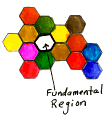
tetrahedron
A polyhedron with four faces.
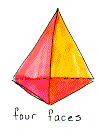
theorem A statement deduced from postulates, definitions, or other previously deduced theorems.
30-60-90
triangle
A triangle in which the three angles measure 30, 60, and 90.

3-dimensional
coordinate system
A system of coordinates used to locate points in space by their distances
and directions from three mutually perpendicular lines.
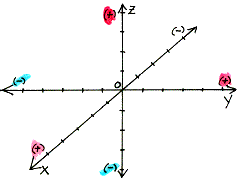
three-dimensional
figure
A figure whose points do not all lie in a single plane.

transformation The movement of a figure in a plane from its original position, the preimage, to a new position, the image. Also called a map. Transformations can occur when there is a reflection, a rotation, a translation, or a glide reflection of the original image.
translation
A transformation in which every point
of the preimage moves in the same direction by the same amount to form
the image. A translation
is also referred to as a "slide".
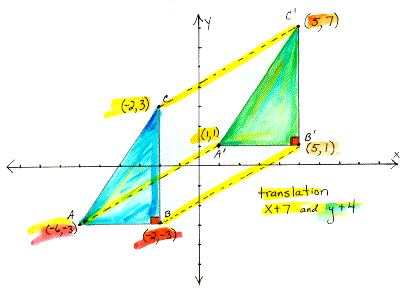
translation image The result of adding the same numbers to the coordinates of the points in a figure. In the drawing above, triangle A'B'C' is the translation image of triangle ABC. Also called slide image.
transversal
A line that
intersects two or more lines.
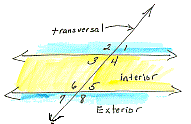
trapezoid
A quadrilateral
that has (at least) one pair of parallel sides.
*NOTE some definitions omit the words at least.
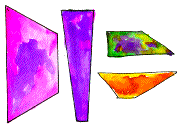
traversable network A network in which all the arcs may be traced exactly once without picking up the tracing instrument.
*NOTE: a network is only traversable if it has less than three odd nodes (an odd node has an odd number of arcs entering it).
trial and error A problem-solving strategy in which various solutions are tried until the correct solution is found.
triangle A polygon with three sides.
Triangle-Sum Property In any triangle, the sum of the measures of the angles is 180°.
triangular region A triangle and the space inside it.
triangulate
To split a polygon into nonoverlapping triangles. Triangulation is usually
used to help find the areas of polygons.
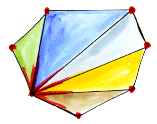
trigonometric
ratio
A ratio of the lengths of the sides in a right triangle.

trillion
A word name for 1,000,000,000,000 ![]() .
.
trillionth
A word name
for ![]() ,
or .00000 00000 01.
,
or .00000 00000 01.
trisect To divide into three congruent parts.
truncate To cut off a number at a particular decimal place. Truncation does not mean that the decimal is rounded up, a part of it is simply cut off.
Ex: 0.666666666666666 truncated to the hundredths place is 0.66.
*NOTE some calculators are programmed to truncate and others to round up. A rounding calculator with a ten digit display would show 0.666666667 for the decimal above.
truth value The condition of a statement in logic; either true or false.
turn A transformation in which every point of the preimage is rotated by a given angle about a point (in two dimensions) or a line (in three dimensions).They are also called rotations.
A turn in the clockwise
direction is considered negative and one in the counterclockwise
direction is considered positive.
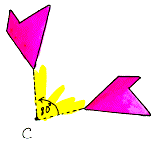
two-column proof A form of written proof in which the conclusions are written in one column and the justifications are written beside them in a second column.
EX:
Given:
Figure ABCDEF as drawn below
Prove:
Figure ABCDEF is not a polygon.
1.) Figure ABCDEF is a union of segments in the plane: 1.) Given 2.) ,
,
,
, and
are the only segments in the figure.
2.) Given 3.) intersects with only
at point B, and point A intersects no other segment.
3.) Given 4.) Therefore, Figure ABCDEF is not a polygon. 4.) It violates the definition of polygon.
two-dimensional Pertaining to figures that lie in a single plane, or to their geometry. This is "flat land" so to speak.
Home | About
Us | Algebra| Dictionary | Games | Geometry | Gym | Humor | Lab | Magic | Natural Math | PreAlgebra | Resources | Teachers Only | Toolbox | Treasures | Videos | Wonders | Writings |
Copyright © 1999-2020 themathlab.com

